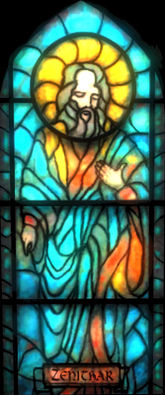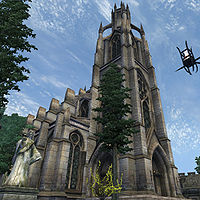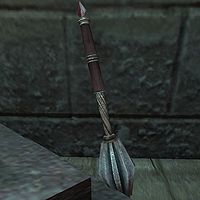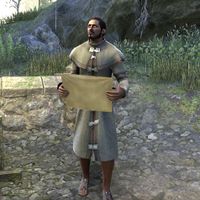Lore:Resolution of Z'en
- "We are a temple devoted to Zenithar, the God of Commerce and Patron of Merchants and Mercenaries. Long ago, in our movement's birth, our forefathers made us a temple like no other: one meant to be adaptable, but resilient to the storm of time. We are thus called Resolutions, a far more descriptive term than temples. The Resolution of Zenithar favors those who favor us -- we do not choose to hide behind words like donations, gifts, indulgences." — A member of the Resolution in Daggerfall
The Resolution of Z'en (also called the Resolution of Zenithar) is the temple dedicated to Zenithar the Provider, God of Work and Commerce. These are generally the place of worship for Zenithar. The Resolution was designed to be adaptable with the current times, but resilient to its unforgiving nature, hence the name. Instead of charity and indulgence, the Resolution favors skill in speechcraft and the arts of mercantilism.[1] The Knights of Iron are the Resolution's militant arm, but they are enemies of the Benevolence of Mara. In the Iliac Bay, the Resolution of Z'en has many chapters, including Gavaudon, Glenpoint, Kairou, Kambria, and Totambu.
Further Information[edit]
Members of the temple are known as resolutes.[2] Since its inception, the Resolution of Z'en has been designed to adapt but remain strong as the times change around them, and the resolution has existed for many untold years. The resolution believe that magicka is generated from existence itself, and when it becomes focused by living beings through a natural process, it becomes accessible to higher beings like the Gods, becoming worship power. And once the Gods attain power from their followers, then they can concentrate it into a godly power that is considered the true essence of magicka.[3] Their temples are decorated with antiquities allegorically illustrating themes of commerce and agriculture, profit and loss, and are befittingly opulent, with walls made of glistening gold, silver, and ebony. Large temples are topped with enormous alabaster obelisks, polished to be highly reflective, and towering a hundred feet high as a symbol welcoming commerce.[UOL 1] The highest position in the Resolution of Zenithar is known as either the Patriarch/Matriarch[4] or the Primate.[5]
The Common Council votes on the promotion of members of the temple.[citation needed]
The Mace of the Crusader (sometimes called the Mace of Zenithar) was kept in the undercroft of the Great Chapel of Zenithar in Leyawiin. After the star-made knight Pelinal Whitestrake was slain by the Ayleids, a messenger carried his mace to the town of Leyawiin, and centuries later, Saint Kaladas the master craftsman built the Great Chapel of Zenithar as a tribute to the legend. When the Saint was finally put to rest in the chapel's tomb, people prayed to Zenithar and received visions of the Mace.
History[edit]
The Redguard resolute, Daluion traveled to the ruined Zenithar's Abbey to find the long-lost Golden Anvil and learn the story of the abbey's arbitrator, Gavos Douar. With the help of an adventurer, they were able to bypass the monsters that inhabited the ruin and recover the sigil keys to the adytum on the east side of the abbey. They found the decrepit and corroded Golden Anvil on the temple's main altar as well as an elderly Gavos Douar, who tried to preserve the anvil for many years. Before Zenithar's faith was forever lost in the abbey and the anvil, Daluion blessed it with the adventurer's toil and it brought holy light back to the Golden Anvil.[6] Shortly after its discovery, Daluion returned to the temple in Leyawiin and informed the Primate of the anvil's location. The Knights of Iron were deployed to recover it and cleanse the abbey.[2]
In 3E 433, the Divine Crusader traveled to the Chapel of Zenithar in Leyawiin to recover the Mace of the Crusader for their quest to unify the Crusader's Relics. They prayed at Kaladas' tomb and were transported to a hidden room that held the mace, separated by a chasm. After a series of failed attempts, the crusader returned with the Boots of the Crusader, a relic of Kynareth and recovered the mace. Once they returned with the artifact, the temple was attacked by Aurorans sent by Umaril the Unfeathered. After successfully defending the chapel, the Divine Crusader also found a new recruit to the Knights of the Nine, Carodus Oholin, a servant of Zenithar.[7]
Knights of Iron[edit]
The Knights of Iron is the militant arm of the Resolution of Z'en. Even though Zenithar has been depicted as God of Commerce and Patron of Merchants, he is sometimes seen as a warrior god, and so the Iron Knights represent this aspect of him.[8] Most of the time, Zenithar is considered a peaceful god, one that prefers peace and prosperity, but even he understands that it has to be earned. The Knights of Iron's purpose is to protect the common folk and ensure they can work unabated.[2] They are known to accept anyone in their cause, even those who lack the talents for a knightly order.[8]
Gallery[edit]
Notes[edit]
- While Zenithar is the God of Commerce to the Bretons and the Imperials, the deity known as Z'en is the Bosmeri god of Toil and Agriculture. He is primarily venerated by the Wood Elves, but his origins are implied to come from the Argonians and the Akaviri. But when the Divines were brought into the Third Empire, Zenithar's name was often shortened and associated with Z'en.[9]
- There is another knightly order in Valenwood called the Stags of Z'en, who represent the Bosmeri aspect of Zenithar. They seek out evil and corruption across the Green and will go through great extremes to eliminate it. One of their roles is the Greenblessed Master of Arms.[10] They were once called upon by High King Aeradan Camoran to take out a threat in the mountain valleys of the Tenmar Forest, one that pertained to a deadly blight and a rogue dragon.[11]
- The magic-wielding knights of Zenithar's Crucible are known to charge into battle atop Iron Atronach Horses; it is said no force can stand against such a charge.[12]
See Also[edit]
- For game-specific information on the Resolution, see the Daggerfall article.
- For game-specific information on the Knightly Order, see the Daggerfall article.
References[edit]
- ^ Resolution of Zenithar description in Daggerfall
- ^ a b c Daluion's dialogue in ESO: Blackwood
- ^ King Edward, Part XII — Anonymous
- ^ Ranks in Daggerfall
- ^ Kantav Cheynoslin NPC in Oblivion
- ^ The Golden Anvil quest in ESO: Blackwood
- ^ The Path of the Righteous quest in Oblivion: Knights of the Nine
- ^ a b Knights of Iron description in Daggerfall
- ^ Varieties of Faith... — Brother Mikhael Karkuxor of the Imperial College
- ^ Crafting Motif 77: Stags of Z'en Style — Gwaerelos, Greenblessed Master of Arms, Elden Root
- ^ The Azure Blight group quest in ESO: Scalebreaker
- ^ Iron Atronach Horse mount in ESO
Note: The following references are considered to be unofficial sources. They are included to round off this article and may not be authoritative or conclusive.
- ^ Ted Peterson's posts in Playing Houses
|
|||||||||||||||||||||||



